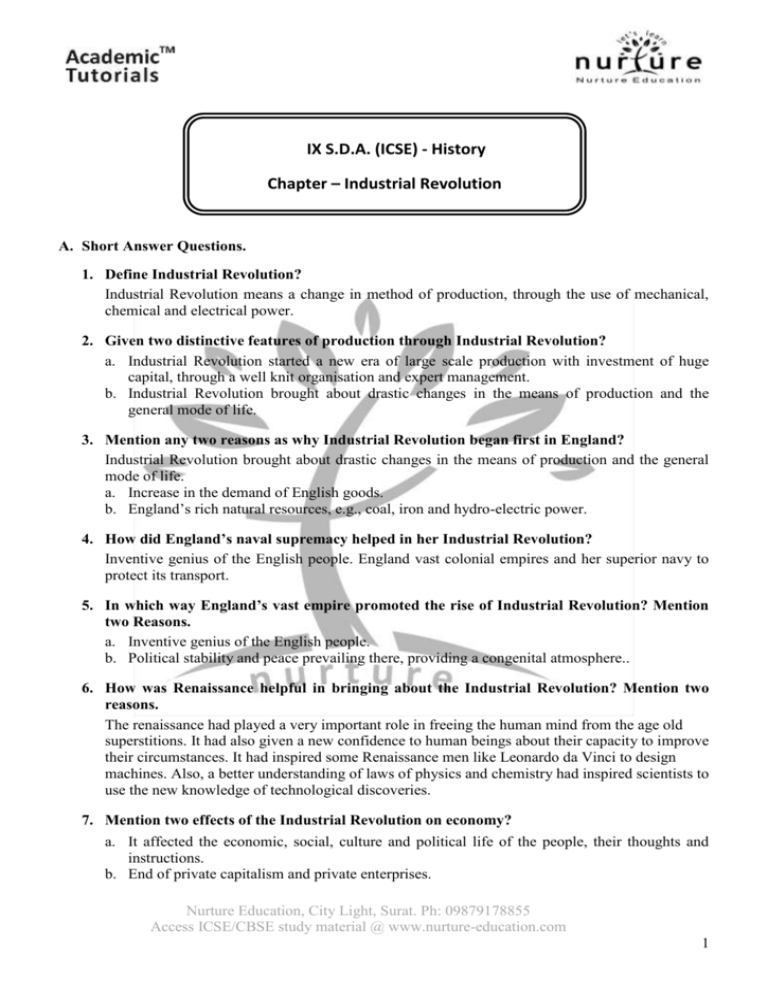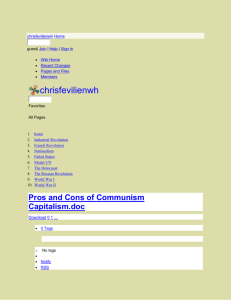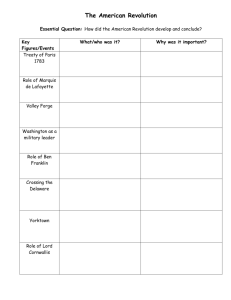Short Answer Questions. Define Industrial Revolution? Industrial
advertisement

IX S.D.A. (ICSE) - History Chapter – Industrial Revolution A. Short Answer Questions. 1. Define Industrial Revolution? Industrial Revolution means a change in method of production, through the use of mechanical, chemical and electrical power. 2. Given two distinctive features of production through Industrial Revolution? a. Industrial Revolution started a new era of large scale production with investment of huge capital, through a well knit organisation and expert management. b. Industrial Revolution brought about drastic changes in the means of production and the general mode of life. 3. Mention any two reasons as why Industrial Revolution began first in England? Industrial Revolution brought about drastic changes in the means of production and the general mode of life. a. Increase in the demand of English goods. b. England’s rich natural resources, e.g., coal, iron and hydro-electric power. 4. How did England’s naval supremacy helped in her Industrial Revolution? Inventive genius of the English people. England vast colonial empires and her superior navy to protect its transport. 5. In which way England’s vast empire promoted the rise of Industrial Revolution? Mention two Reasons. a. Inventive genius of the English people. b. Political stability and peace prevailing there, providing a congenital atmosphere.. 6. How was Renaissance helpful in bringing about the Industrial Revolution? Mention two reasons. The renaissance had played a very important role in freeing the human mind from the age old superstitions. It had also given a new confidence to human beings about their capacity to improve their circumstances. It had inspired some Renaissance men like Leonardo da Vinci to design machines. Also, a better understanding of laws of physics and chemistry had inspired scientists to use the new knowledge of technological discoveries. 7. Mention two effects of the Industrial Revolution on economy? a. It affected the economic, social, culture and political life of the people, their thoughts and instructions. b. End of private capitalism and private enterprises. Nurture Education, City Light, Surat. Ph: 09879178855 Access ICSE/CBSE study material @ www.nurture-education.com 1 8. Mention the names of atleast four inventors of the textile machines, write the names of the machine and the year? John Kay - Flying Shuttle; 1783, Edward Cartwright - Powerloom; 1785, Richard Arkwright - Water Frame; 1796 James Hargreaves - Spinning Jenny; 1765 Eil Whitney - Cotton Gin; 1793 9. Mention kinds of Machine were developed for ginning and spinning in the 2 nd half of 19th century and by whom? John Kay - Flying Shuttle; 1783, Edward Cartwright - Powerloom; 1785, Samuel Crompton - spinning Mule; 1799, Robert Fulton - Steam boat; 1807, Michael Faraday - Dynamo; 1831 James Hargreaves - Spinning Jenny; 1765 Eil Whitney - Cotton Gin; 1793 Elias Howe - Sewing Machine; 1846 George Stephenson - Locomotive engine; 1814 10. Who invented the steam power and when? Henry Cort in 1790 11. Who made smelting of iron possible and when? In 1709 A.D. Abraham Darby discovered the art of smelting iron with coke. 12. Mention the four means of transport and name the inventors? James Watt - Steam engine; 1782, Robert Fulton - Steam boat; 1807 Michael Faraday - Dynamo; 1831, George Stephenson - Locomotive engine; 1814 13. Who developed Telegraph, Telephone and Wireless Telegraph and when? Samuel Morse - Telegraph; 1846, Alexander Graham Bell –Telephone;1876 Marconi - Wireless telegraphy;1866 14. Who were the inventors of electric bulb, dynamo and electricity and when? Thomas Edison – electric bulb; 1765, Michael Faraday - Dynamo; 1831 Benjamin Franklin – electricity; 1750 15. How was the supply of cotton, coal and iron helpful in the coming Industrial Revolution in England? Rich natural resources of these in the northern regions of England; most factories developed in this region; coal was also available to run the steam engine and provide energy like electricity; cotton in plenty was produced in England, hence cotton textile industry became the pioneer of the Industrial Revolution. 16. Mention the two main points relating to coming of urbanization as an impact of Industrial Revolution. a. Expansion of trade and commerce led to the expansion of new ones all over the world. b. Large numbers of the rural poor went and settled in factory-towns and commercial cities in the hope of higher wages and better living conditions. 17. Give two main cause of the rise of Socialism. a. Division of Society into two classes – the rich capitalists and the poor workers. b. Destruction of Cottage Industries. Nurture Education, City Light, Surat. Ph: 09879178855 Access ICSE/CBSE study material @ www.nurture-education.com 2 18. Define Socialism and give its two main features. Socialism is direct reaction against the capitalist system, which was the outcome of Industrial Revolution. Socialism means that all source and means of production, distribution and exchange should be collectively owned, managed and used by the society as a whole and for benefit of all. Emphasis on bring great equality into social condition. Emphasis on welfare of the people including medical care, education and social security to all the citizens. 19. Name the exponents of Democratic Socialism in India. In India, the Gandgi, Vinobha Bhave, Congress socialist Party and Jaya Prakash Narayan (J.P) advocated Democratic Socialism. B. Structure Questions. 1. With Reference to Industrial Revolution, discuss the following. (a) Meaning of Industrial Revolution. The term Industrial Revolution was first used by French Socialist, Blanqui in 1837. Later on it was adopted by Arnold Toynbee, a British historian of repute. It ushered in the machineage for the production of goods in factories. The term Industrial revolution conveys a system of manufacturing on a large scale, with the help of machines driven by mechanical, chemical or electrical energy. (b) Its emergency in England and its causes. Scientific inventions and discoveries made towards the close of the 18th century of the beginning of the 19th century, led to the change from manual work to machine work and from domestic system. Industrial Revolution started a new era of large scale production with investment of huge capital, through a well knit organisation and expert management. Industrial Revolution turned out to be the Biggest Revolution in the entire history of mankind. Industrial Revolution brought about drastic changes in the means of production and the general mode of life. (c) Role of coal, iron and cotton in England. England had a rich coal and iron deposition. During the 19th century, coal was the most powerful fuel. It powered the stem engines that made the Industrial Revolution possible. Coal was also essential raw material for making many products, the most important of which are iron and steel it is also used in the production of electricity. Even coltar as also made from coal, and the same was used in making concrete roads, for easy transportation it was also used for making chemicals. England had rich cotton resource. Hence textile industry developed in there. 2. The Industrial Revolution is called the Age of machines. In this regards discuss. (a) Machines for textile industry, their inventors and year of invention. England had rich cotton resource. Hence textile industry developed in there. Most of the machines developed in the second half of the 18th century in England were related to cotton and textile. In 1765 came Spinning Jenny, which could turn eight spinners at a time. In 1783, was made the Flying Shuttle for speedy weaving of loomed cloth b John Key. In 1785, there came the power loom, which enabled one spinner to operate 100 spindles single handed. To separate Cotton Gin, which did the work at a speed 300 times faster than before. The Mule Nurture Education, City Light, Surat. Ph: 09879178855 Access ICSE/CBSE study material @ www.nurture-education.com 3 was developed in 1799 in order to combine the advantages of Spinning Jenny and Waterframe and produce an even stronger thread from cotton. And in 1846, was developed the first Stiching / Sewing machine to stitch cotton cloths. (b) Invention of Steam Power. In 1782 invention of the steam engine made revolution possible in transportation. With the invention of the first stream boat by Robert Fulton in 1833 crossing of Atlantic Ocean in just 15 days by ‘Great Western’ ship, man became the master of seas. He invented steam engine improved then made by Henry in year 1728, he used steam pressure to push the piston and turn the where. This engine was also called “Bell Zebub”. (c) Means of Transport and communication. Industrial Revolution developed the rail and road transport system. With the use of faster, safer and cheaper transport, national markets grew up in towns. A large section of people engaged themselves in trade and commerce. Most of this was carried on in big cities and the new towns that had grown up. (d) Electricity and steam power. The miraculous power of electricity helped man when its use was recognised by the American Scientists Benjamin Franklin. The use of electricity replaced steam power in many factories and industries. It was through electricity number of inventions took place like telegraph, telephone, radio, television, refrigerator etc. 3. In the light of the vast impact of Industrial Revolution, discuss. (a) Urbanization and its effects on general life. Expansion of trade and commerce led to the expansion of new ones all over the world. Large numbers of the rural poor went and settled in factory-towns and commercial cities in the hope of higher wages and better living conditions. Industrial Revolution developed the rail and road transport system. With the use of faster, safer and cheaper transport, national markets grew up in towns. Due to large scale production of quantity of items at cheaper rates, most of the goods came within the reach of the people. It made the life more comfortable and easier. Usually the factories were situated near the coal-field or sea ports. No such attention was paid towards providing suitable houses for the industrial workers. So the workers in the town lived in the over-crowded and poor housing conditions. The law of England required all farms to fence their fields. Those who could not effort to do so, sold their small farms. This led to the disappearance of small farms and the small farmers. Industrial Revolution led to vice like drinking, gambling, crime and sin in the urban life and conduct of both rich, because of their affluence, and the poor because of their poverty. People had to work long hours under hard condition in the factories. Exploitation began with low wages and use of child labour. (b) Rise of Capitalism and its effects. Industrial Revolution gave rise to the capitalism as a system of economy. Big industries, producing goods at a mass scale and at cheaper rates, converted the workers into mere wage earnings, while the factory owners made a huge profits and amassed wealth. The capitalists owned the means of production and managed the industrial units. The workers were not only low-paid, but they had also no share in the industrial management. Sufferance exploitation at the capitalist became their lot. Nurture Education, City Light, Surat. Ph: 09879178855 Access ICSE/CBSE study material @ www.nurture-education.com 4 (c) Rise of Socialism as a remedial philosophy. Division of Society into two classes: The Industrial Revolution divided the society into two classes, the rich capitalists and the poor workers or the haves and the have-nots. The interest of both the classes clashed with each other diametrically. This led to emergence of class-war. Socialism was a philosophy to end the class war. Miserable conditions of the Factory Workers: the condition in which the factory workers worked were very miserable. The factory premises were unhealthy, poorly ventilated and badly lightened. Moreover, the working hours ranged from 16 hours to 18 hours per day without a break. Such condition spread several diseases and led to premature death of the workers. Women and small children, who were available at even cheaper wages, had to suffer even more miseries. A solution to these problems was sought in Socialism. 4. Socialism originated as a direct reaction to the evils of Industrial Revolution and Capitalism. With reference to the above discuss. (a) Meaning and features of Socialism. Socialism is direct reaction against the capitalist system, which was the outcome of Industrial Revolution. Socialism means that all source and means of production, distribution and exchange should be collectively owned, managed and used by the society as a whole and for the benefit of all. Society is more important than individual Emphasis on planned economy in an organized and controlled manner. Emphasis on bring great equality into social condition. Emphasis on welfare of the people including medical care, education and social security to all the citizens. (b) Causes of the Rise of Socialism. (Same as Ans B 3 (c)) (c) Exponents of Utopian, Scientific and Democratic Socialism. Early Utopian Socialists: (i) Babet (ii) Saint Simon (iii) Fourier (iv) Robert Owen, who was the father of British Socialism. Marxian Socialism: Karl Marx propounded scientific socialism. Its main ideas are: Economic interpretation of history and as the factor responsible for the inevitable change Labour theory of value Surplus theory of values Class war Self destruction of Capitalism Nationalization of all resources and end of private capital and private enterprise Armed revolution, the only way to end capitalism Dictatorship of the Proletariat till class-less and stateless society is established. Democratic Socialism: In India, the Gandgi, Vinobha Bhave, Congress socialist Party and Jaya Prakash Narayan (J.P) advocated Democratic Socialism. Nurture Education, City Light, Surat. Ph: 09879178855 Access ICSE/CBSE study material @ www.nurture-education.com 5







